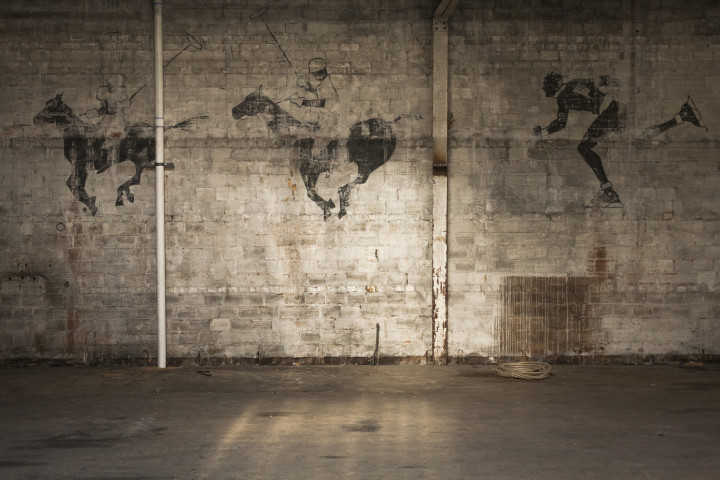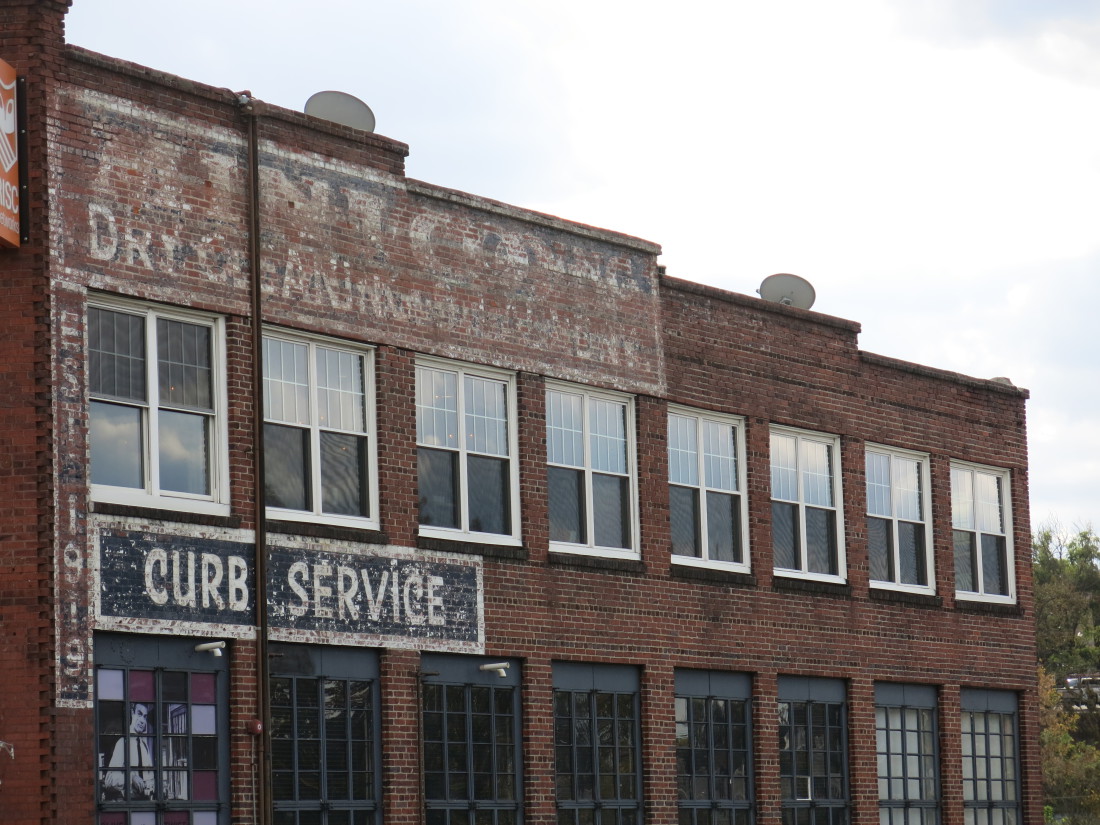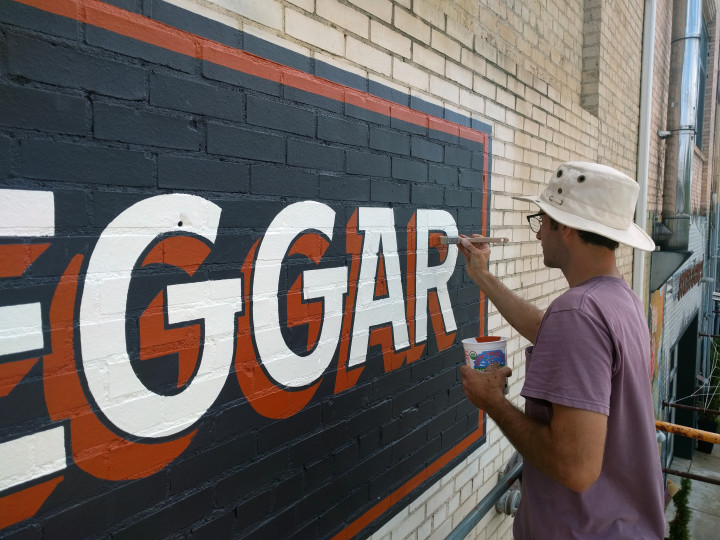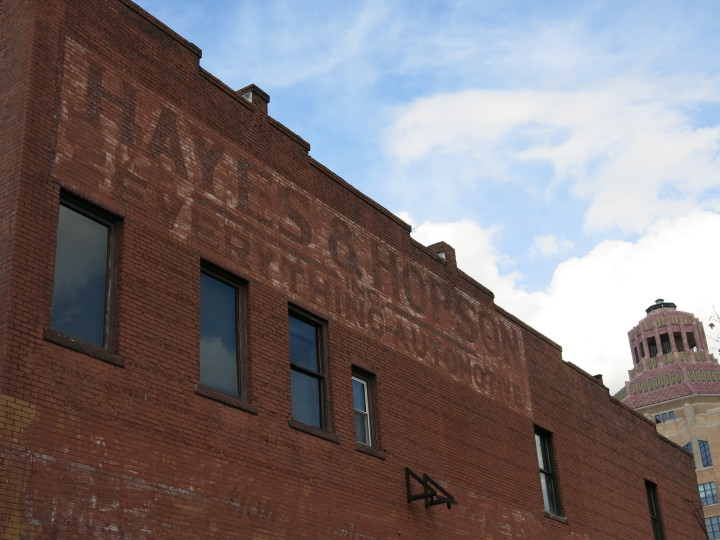The Halloween candy is probably gone. Rot has set in on the jack-o’-lanterns. The ghosts, goblins and other graveyard lawn decor have been broken down, boxed up and put to bed till next year. Yet certain other ghosts still linger: ghost signs, those fading advertisements painted on the sides of old buildings.
In Asheville they are legion. Entering downtown by way of Merrimon Avenue, you’ve probably seen the black-and-white dry cleaning sign on the exterior of Olive or Twist restaurant and bar. “Curb Service,” it proudly proclaims, and in the left-hand corner is the former business’s year of establishment: 1919.
There are many others. On the back wall of the former Vincenzo’s Ristorante on North Market Street the words “Printers Binders” are now barely legible. Down the block, on College Street, “Traffic Management School” is visible on the building housing the Asheville Music School and Sola Salons. Several old advertisements adorn the exterior of Pack’s Tavern — “Hayes & Hopson Inc. Everything Automotive” can be seen on its south wall, while “Builders Hardware, Mantles Grates, Tiling And Fireplace Fixtures” is slowly disappearing from the building’s eastern side.
These and other such markings “speak to a time that was,” says Alex Cole, the city’s historic review specialist. Asheville, she says, supports the idea of preserving ghost signs, but her department lacks the resources to do so. “We do design review for locally designated historic properties,” she explains. “If there were any historic signs associated with those, we would do a review for any potential changes. … I’m not familiar with any of those buildings having ghost signs.”
But in general, she continues, “I think they’re kind of interesting in the state that they’re in.”

A sense of wonder
“I guarantee you can find a number of people who work in downtown Asheville that walk past a sign every single day of their lives and have never seen it,” says Jack Thomson, executive director of The Preservation Society of Asheville and Buncombe County.
Ghost signs, he maintains, create “urban grain” — the layering effect of time on any given building, which enables those so inclined to play detective. Thomson, in fact, delights in discovering new ghost signs. He’ll spend several minutes scrutinizing the faint letters before heading to Pack Library’s North Carolina Room, where he’ll search old city directories to pinpoint when the enterprise existed at that location.
In 2014, Thomson led a downtown ghost sign walking tour aimed at educating people on “how to look at a building, but also how to see the building — not just glance at it.” These signs, he says, help “create a sense of wonder that enhances the interest in a place that has benefited from age.”
Wall dogs
Before the invention of boom lifts, sign painters had to rely on less stable means of support. “You were kind of in a precarious position in those days,” says John Cheadle, who owns Cheadle Sign Works. Throughout the early 20th century, a block and tackle was sign painters’ only means of leverage.
Cheadle, whose father opened a sign shop in the family’s Asheville home back in 1959, began working full time in the family business in 1974. “We used to have stirrups that you put your workboard in, and you had a big pulley. You’d go up and down on the wall with an old rope,” he recalls. “We used to hand-paint billboards for Ghost Town and Frontier Land — amusement places in Cherokee. We also hand-painted all the Biltmore House billboards. … I wish I had some photos of that; I don’t think I have.”
Fellow sign shop owner Larry Colemon has similar memories. “Wall dogs, that’s what we called the guys who painted the walls,” he explains. Until the mid-’80s, everything was done by hand. But the introduction of the Gerber IVB, which cut vinyl and plotted layouts, “revolutionized the industry,” says Colemon. “It was so much easier to repeat yourself when you got everything on a screen and you just plug it in.” There was a downside, however: “You feel like you’re just a robot. You don’t feel like you’re really creating anything anymore.”
Fast and loose
Timothy Maddox began documenting ghost signs in 2011. Over the last five years, he’s photographed thousands of images in Western North Carolina, Eastern Tennessee, parts of Mississippi, California and the Big Island of Hawaii. “I’ve always done lettering art,” he says. “But seeing fading signs on the streets and seeing the brush strokes … such finesse!” That infatuation led Maddox to learn the craft. Based in Asheville, he now makes his living as a full-time traditional sign maker.
Maddox’s passion for sign painting is matched only by his enthusiasm about its history. “Some wall dogs,” he says, “would just lay it out. They were used to working big and right up against a building and could just lay it out with a yardstick and chalk. … If there was a pictorial or some graphic or a very specific type of lettering, oftentimes they’d use a grid system.
“It’s a craft,” he continues, “only this one is related to commercial advertisement, and so it gets replaced really easily.” The appearance of the signs offers clues as to when they were painted, Maddox explains. “Script in the early part of the 20th century would have been very controlled, very defined, clean, crisp. When you get into the ’60s, the script becomes really loose and looks more like it came off the tip of a brush, more rapid-looking.”
New discoveries
Michael Files, the brand director for Buxton Hall Barbecue, remembers the first time he stepped inside the South Slope building that now houses the eatery. On the walls were murals of ice skaters, skiers and polo players. “It influenced our decision on how we wanted to set up the restaurant,” he notes. Realizing that the kitchen equipment would cover up and potentially damage some of the images, Files and co-owners Meherwan Irani and Elliott Moss opted to place the kitchen at the south end, where the murals showed the greatest wear.

Layout aside, the paintings also sparked curiosity about the building’s history. Research, says Files, revealed that they originated in 1936, when the building was home to the Asheville Skating Club. The roller-skating rink served the African-American community, and “We theorize that [the murals] were done to commemorate the Berlin 1936 Olympics, when Jesse Owens represented the United States,” he explains.
Over on North Lexington Avenue, workers renovating No. 37 in preparation for the new Anthropologie boutique uncovered a pristine 1946 Dr Pepper advertisement whose colors are still radiant. “It’s never been restored,” says apparel supervisor Jen Raven. “It’s a great conversation starter: Most folks are used to seeing Coke murals. It feels unique that we have the Dr Pepper one.”
Plastic history
A recurring theme among the preservationists, historians, craftspeople and business staffers who spoke with Xpress was this somewhat troubling question: Is there a way to preserve these historic signs without compromising their authenticity?
Thomson of the Preservation Society has given this a lot of thought. “Restoration is an option, though oftentimes the work makes the signage too fresh, giving misleading clues of age,” he explains. “There are methods of arresting further deterioration, but care must be taken that the treatment doesn’t adversely affect the underlying substrate. Doing nothing is an option, but of course, loss will continue.”
Maddox actually offers clients the option of new signs that look old. The technique, which involves toning down colors to maintain a duller look, is also available for restoring old signs. The artist, however, must first study the existing work to better understand how it was created. “As the paint breaks down, you start to see the construction of the letters,” he says. “They become very tactile because you can see where the paint was thicker and where it was thinner, based on how the paint came off the brush, which is often very indicative of how the letter was created. … You kind of see what were the really important strokes to define the letter and what was more of the fill-in.”
But Buxton Hall, which uses Maddox for much of its sign-related work, wasn’t interested in the faux approach. “As Elliott put it, we want to ‘earn the fade,’” Files explains. “There’s something rotten at the core of American businesses trying to capture a sense of nostalgia without putting in the difficult work of what made some aspects of the past great.”
Thomson concurs. Although a new “faux-aged” sign may be commendable as a piece of public art, he worries what effect this approach may have on “the future interpretation of the buildings they’re painted on.” Such signs, says Thomson, convey a “false sense of authenticity” that he fears may “really just be a device used by out-of-town enterprises that are eager to put forward their own sense of authenticity.”
When it comes to restoring older signs, however, Thomson sees the technique as the ideal way to strike a balance, letting the sign show its age without completely fading away. In such cases, he maintains, full restoration would be “too much of a plasticized, Disney World version of history.”
Going, going, gone…
Like the city, the Preservation Society lacks the resources to try to preserve Asheville’s ghost signs, though Thomson says he’d probably be doing it “if we had better bandwidth, if I had a preservation director and an education director.” These artifacts, he points out, “create a tangible connection to the past. They remind us that there was somebody before us and there’s going to be somebody after us.”
Others, such as Colemon, say the signs may trigger simple nostalgia: “Everything old is new again.” Now 68, the former wall dog still operates his West Asheville sign shop, though he no longer gets up on a ladder. As we continue discussing the matter, however, his thoughts return to the craft. “As I get older, my body is rebelling,” he says. “It’s getting to where arthritis and things like that are messing with me to the point where even handling a brush is not the snap it used to be. … But there are people who appreciate people like us who are able to do the handwork. I don’t ever want to lose it.”
Cheadle agrees, saying, “There’s an art to the hand-painted signs, and you don’t like to see that go away.”
Maddox, meanwhile, is in the early stages of creating an online archive where he plans to share the images he’s captured over the last five years. Eventually, Maddox hopes signpaintingarchive.org will foster more research and study of the craft in America. The site, he says, will also enable others to upload and share their own ghost sign discoveries, adding, “It would focus on different regional styles that developed in different decades, and link it to different industrial and economic booms.”
Remembering the old Harley-Davidson sign that was removed from the south wall of the former Smashing Guitars music store on Broadway during recent renovations, Maddox says, “I always get sad when that happens: When it’s gone, it’s gone.”






Very interesting article. Thanks for a look back.
Old is not synonymous with historic.
This was an interesting, well researched, and well written article ! Reading it made me think of the 50’s Buddy Holly tune “Not Fade Away” (which later covered by the Dead around ’70) . I hope these images dont. I believe the “Traffic Management School” was part of Cecil’s Business College or Blantons’s Business College.
Fun article.
When I was a kid, I can remember going downtown with my parents in the late 70s/early 80s, and there was this really funky, almost psychedelic, painted ad for 7-Up. I want to say it was on the wall above the parking lot at Walnut and Lex, because that’s where we always parked when they took me to get shoes at TOPS. Anyone else remember that ad?
The old painting on the side of the Minico-Carr cleaners brings back clear memories of when that place was actually a laundry – on a cold day it seemed like steam came out of every crack and crevice in that building! I believe they used to have contracts for a lot of hotels and institutional laundry and had those huge flatwork presses to do bed linens with….Does anyone remember the little “Bear Service” signs that used to be on some auto repair shops? Seems there was on on S. Lexington and one in West Asheville that I remember…. http://fill-er-up.com/store/bear-service.html